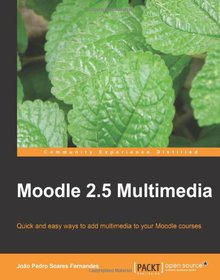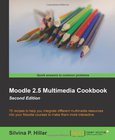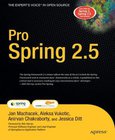Moodle 2.5 Multimedia

Book Details:
| Publisher: | Packt Publishing |
| Series: | Packt |
| Author: | Joao Pedro Soares Fernandes |
| Edition: | 1 |
| ISBN-10: | 1783281472 |
| ISBN-13: | 9781783281473 |
| Pages: | 270 |
| Published: | Nov 25 2013 |
| Posted: | Nov 19 2014 |
| Language: | English |
| Book format: | |
| Book size: | 15.3 MB |
Book Description:
Quick and easy ways to add multimedia to your Moodle courses Overview Gives ideas to teachers and trainers on how to use multimedia effectively in Moodle Plenty of screenshots and a step-by-step approach, with tips on how to use simple and free software tools and web applications to improve your course Focus on both the creation of instructional materials and the design of students activities around multimedia where they have an active role in creating, discussing and assessing their work Based on the development of a Moodle course about music, with connections to other subjects and a broad range of activities In Detail Multimedia is a very old human endeavor. It has taken mankind almost 30,000 years since painting on cave walls to get a combination of text, image, sound, and video all working in the same medium, that is, in motion pictures. Finally, after thousands of years of human history, we can all (not just an elite few) create multimedia easily using Moodle. Moodle was built around an idea of learning that happens when a group of people construct things for one another, collaboratively creating a small culture of shared artifacts with shared meanings. A tutorial-based guide, with clear illustrations and examples of how to create, convert and add multimedia to Moodle using a range of free e-learning software tools and web applications. This book follows the design of resources and activities for the course Music for everyday life. The tasks presented are quick and easy to do for teachers and trainers with busy schedules. Giving readers an insight into the creation and integration of multimedia in Moodle courses. Starting with images you will learn to create photo collages, screenshots and comic strips. Then you will discover audio and how to extract audio from CDs to create a soundtrack for a movie and a podcast. Later, you will use video to produce a trailer for a movie, photo slideshows, online TVs and screencasts. Following that, you will develop an understanding of interactive elements and web communication, such as online maps, interactive timelines or web meetings. Finally, you will look at multimedia quizzes and assessment of multimedia assignments, ending with general issues on copyright, licensing and safety. A focus of the book is to show readers that using multimedia is not just about improving instruction, but also improving the ways in which students can can now create multimedia easily, and share it without great effort.. To make this easier, many of the moodle tutorials in the book will be based on activities designed for students to create, discuss and assess each others multimedia works. What you will learn from this book Create and edit images, drawings, screenshots, audio, music, and video Understand copyright and licensing of multimedia works, particularly public domain and creative commons licenses Discover basic procedures to create videos with simple equipment to add as course resources and activities Download and publish videos in online video sharing services Convert between several video formats and integrate them in Moodle Develop multimedia elements such as interactive floor planners, interactive presentations, online maps, diagrams, concept maps and timelines using web applications and blend them with Moodle Learn how to interact with students in real-time using synchronous communication and screen sharing applications
Download Link:
Related Books:
Moodle 2.5 Multimedia Cookbook
2nd Edition
75 recipes to help you integrate different multimedia resources into your Moodle courses to make them more interactive Overview Add all sorts of multimedia features to your Moodle course Lots of easy to follow, step by step recipes Work with sound, audio and animation to make your course even more interactive In Detail Moodle is an open source virtual learning environment that is widely used in schools and businesses, specifically multimedia elements to enhance the user experience. Moodle 2.5 Multimedia Cookbook provides quick recipes to make your Moodle courses more fun and engaging for your audience, taking you beyond the standard. This cookbook ...
Pro Spring 2.5
The move from socalled heavyweight architectures, such as Enterprise JavaBeans, toward lightweight frameworks, like Spring, has not stopped since Pro Spring was published by Rob Harrop and Jan Machacek in 2005; in fact, its picked up pace. The Spring Framework remains the leader in this move and provides a platform on which you can build your own applications and services. Pro Spring 2.5 covers the new features of Spring 2.5, but moreover, it is focused on the best practices and core standards of contemporary Spring development. As members of the Spring development team at Cake Solutions, the author team brings extensive practical experience gained from working with Spring since version 1.0 and delivering successful systems on top of it. Learn the ...
Character Development in Blender 2.5
Written for everyone from beginning Blender artists to experienced animators and game developers, CHARACTER DEVELOPMENT IN BLENDER 2.5 shows readers how to model believable characters using Blender, a free, open source 3d animation package. Covering the technical, artistic, and theoretical aspects of character development, the book provides an in-depth look at Blender's modeling tools and includes information on modeling, sculpting, materials, lighting, rendering, and more. Written in a tutorial style with step-by-step instructions the book also includes an accompanying CD-Rom that features the Blender 2.5 software and sample art. About the Book Character Development in Blender 2.5 provides instruction both to Blender and to character modeling, expl...
2007 - 2021 © eBooks-IT.org



